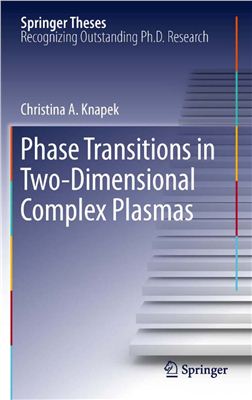Springer Theses, Springer-Verlag, Berlin, 2011, 158 pages
The two experimental studies reported in this thesis contribute important new knowledge about phase transitions in two-dimensional complex plasmas: in one case a determination of the coupling parameter (ratio of mean potential to mean kinetic energy of the particles in an ensemble), and in the other a detailed characterization of the non-equilibrium recrystallization of a two-dimensional system. The latter results are used to establish the connection between structural order parameters and the kinetic energy, which in tu gives novel insights into the underlying physical processes determining the two-dimensional phase transition.
A complex plasma, in the most basic sense, consists of a mixture of electrons, ions, neutral gas atoms and charged micrometer-sized particles. These complex plasmas can spontaneously self-organize and form ‘‘plasma crystals’’. The work presented by Dr. Knapek deals with the phase state and phase transitions in the 2D complex plasma, leading to the question how significantly the thermodynamical behavior in two dimensions differs from that in three dimensions.
The two experimental studies reported in this thesis contribute important new knowledge about phase transitions in two-dimensional complex plasmas: in one case a determination of the coupling parameter (ratio of mean potential to mean kinetic energy of the particles in an ensemble), and in the other a detailed characterization of the non-equilibrium recrystallization of a two-dimensional system. The latter results are used to establish the connection between structural order parameters and the kinetic energy, which in tu gives novel insights into the underlying physical processes determining the two-dimensional phase transition.
A complex plasma, in the most basic sense, consists of a mixture of electrons, ions, neutral gas atoms and charged micrometer-sized particles. These complex plasmas can spontaneously self-organize and form ‘‘plasma crystals’’. The work presented by Dr. Knapek deals with the phase state and phase transitions in the 2D complex plasma, leading to the question how significantly the thermodynamical behavior in two dimensions differs from that in three dimensions.

